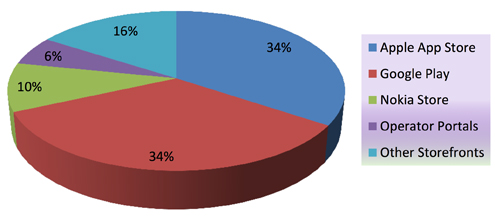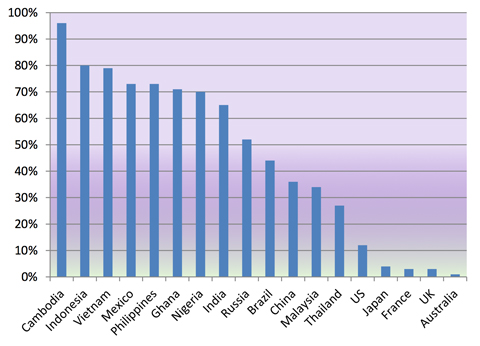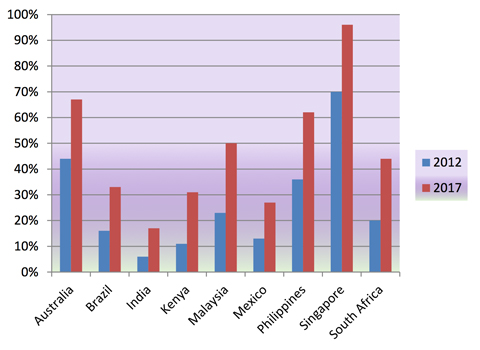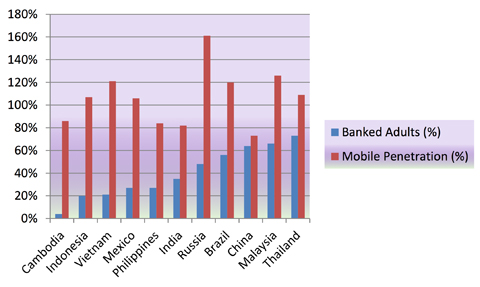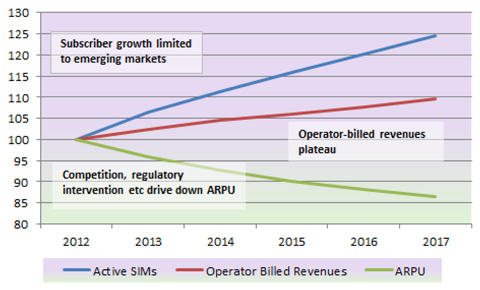How building a framework for mobile payments that keeps the consumer experience in mind will go a long way towards developing consumer trust and widespread adoption of these new products and services
by Juniper Research
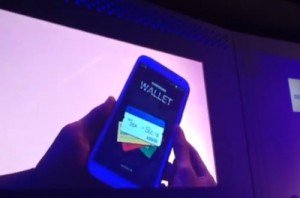 The mobile device offers a near ubiquitous channel to reach large numbers of unbanked consumers. Over the past five years, the mobile marketplace has undergone a quite dramatic evolution. The role of the handset has transitioned from an enabler of voice and text communications to an essential multipurpose tool, one on which the consumer can browse the Internet, watch video content and pay for goods and services (both remotely and, increasingly, at the physical point of sale). The payment of goods and services via the mobile is hardly a new concept: what has changed (and dramatically expanded) are the billing mechanisms on offer to the consumer, and the nature of those goods and services which can be purchased. A number of factors have combined to shape this new marketplace: the mass adoption of consumer smartphones in tandem with large data bundles; the emergence of a consumer tablet market; the launch of several high-profile application storefronts followed by the mass adoption of a variety of application categories far beyond the traditional game.
The mobile device offers a near ubiquitous channel to reach large numbers of unbanked consumers. Over the past five years, the mobile marketplace has undergone a quite dramatic evolution. The role of the handset has transitioned from an enabler of voice and text communications to an essential multipurpose tool, one on which the consumer can browse the Internet, watch video content and pay for goods and services (both remotely and, increasingly, at the physical point of sale). The payment of goods and services via the mobile is hardly a new concept: what has changed (and dramatically expanded) are the billing mechanisms on offer to the consumer, and the nature of those goods and services which can be purchased. A number of factors have combined to shape this new marketplace: the mass adoption of consumer smartphones in tandem with large data bundles; the emergence of a consumer tablet market; the launch of several high-profile application storefronts followed by the mass adoption of a variety of application categories far beyond the traditional game.
The upshot has been the development of a mobile payments market which reached $340 billion in 2012 and is expected to reach $1.3 trillion annually by 2017. It is worth highlighting the key trends which are at the heart of this transition, their implications for mobile payments and what they mean for network operators.
OTT storefronts
The mobile payments market – and its constituent entities – has evolved dramatically in the past decade. From a market comprised almost exclusively of on-portal ringtone and logo sales, we now have a digital market driven by sales of rich media content through OTT app storefronts: in 2012, Apple’s App Store and the Android Market (now Google Play) accounted for nearly 70% of global app downloads (see Figure 1 below). It is worth observing that this growth has been facilitated by the advent of the consumer smartphone: the installed base of such devices has grown from 260 million in 2008 to more than 1 billion in 2012. Furthermore, given Android’s increasing dominance of the smartphone OS space, we believe that Google Play’s share of app downloads will increase from 34% in 2012 to 47% by 2017.
At the same time, it is also worth observing that as Windows 8 gains traction as a smartphone OS in the medium term following Nokia’s decision to adopt Microsoft’s OS for its own devices, then the Windows Store also has the potential in the medium term to acquire a significant share of the apps market, further eroding the share of the operator portals.
We would estimate that this share will increase from less than 0.1% in 2012 to more than 9% by 2017. At the same time, the traditional paid app payment mechanism has been complemented by a variety of alternatives (freemium, ad-supported, search etc.) while the emergence of in-app billing mechanisms for digital content offers content providers further opportunities to monetise their content post the initial download. Furthermore, the mass adoption of consumer smartphones has in turn resulted in a significant number of end users possessing devices with user interfaces which are increasingly conducive to browsing and purchasing – physical goods.
Data from mobile payment schemes informs us that content providers are experiencing uplift in transaction size. There are a number of reasons behind this. First is that carriers are now enabling higher price points for digital purchases. The second is that the introduction of payment mechanisms such as Direct Carrier Billing – enabling continuous pricing rather than discrete price points as with Premium SMS (PSMS) – becomes more attractive from a developer/merchant perspective, allowing them to offer a price of their own choosing rather than be obliged to select a ‘best fit’ price.
Mobile wallet
Data from mobile payment schemes informs us that content providers are experiencing uplift in transaction size. There are a number of reasons behind this. First is that carriers are now enabling higher price points for digital purchases. The second is that the introduction of payment mechanisms such as Direct Carrier Billing – enabling continuous pricing rather than discrete price points as with Premium SMS (PSMS) – becomes more attractive from a developer/merchant perspective, allowing them to offer a price of their own choosing rather than be obliged to select a ‘best fit’ price. An example of this occurs within Google Play, which offers direct carrier billing in the UK: for the 100 leading paid applications as of January 2013, there was a range of 57 different prices. Conversely, in Apple’s App Store in the US, apps retailed at just 7 discrete price points ($0.99, $1.99, $2.99, $3.99, $4.99, $5.99 and $6.99). (It should be observed that Apple allows a range of price points up to $999.99, but that the highest price point of any app within the top 100 was $6.99.)
At the same time, it is worth pointing out that part of this trend is attributable to a wider willingness to pay for content – itself in large part engendered by the richer content (and greater variety of content) produced in the wake of the app explosion. It is also worth observing that such payments are becoming more frequent in the physical goods arena, with retailers of physical goods also experiencing uplift in basket size (average transaction size) as a result of replacing cash with a mobile payment method. This itself is a direct result of increased consumer confidence in, and willingness to engage with, the mobile device as both a content browsing and payment mechanism.
In 2012, it was reported that 3,500 cars were being sold per week via eBay’s mobile channels. While the case studies and profiles within this report provide individual examples of mobile’s success in this field, it is worth grouping several other key examples together collectively to demonstrate this: For the pizza takeaway company Domino’s (UK), mobile accounted for 20% of online checkouts in 2012; in the US, by November 2012 the Domino’s ordering app for iOS and Android had been downloaded nearly 3.5 million times, with mobile accounting for 7% of all Domino’s sales
UK supermarket Asda saw 16% of online orders conducted via the mobile by Q3 2012; UK retailer Argos saw 7% of all its orders conducted via the mobile in the six months ended September 2012: In Japan, the leading online retailer Rakuten is seeing 25% of transactions originate on the mobile device Globally, PayPal Mobile handled $14 billion in mobile transactions in 2012, up from $4 billion in 2011
Building on this increased consumer desire to use the mobile device as a purchasing mechanism, not merely remotely, but also for proximity payments, various groups of networks operators have formed consortia with the aim of establishing ‘mobile wallet’ solutions which – as well as permitting consumers to store coupons and loyalty cards on-device – also enable payment via NFC (Near Field Communications). Key examples here include ISIS (an MNO-led consortium of AT&T, T-Mobile US and Verizon, which began trialling in Austin, Texas and Salt Lake City, Utah in October 2012) and the Cityzi project in Nice, France where MNOs, banks and transport operators share a common NFC infrastructure.
Developing economies
Cash has been king for centuries and it will remain an important method of payment for many years to come, especially in developing countries. However, Juniper Research has found that mobile payments are gaining in popularity in developing countries where steps are being made to develop mobile-based economies. Furthermore, several mobile remittance services have enjoyed quite remarkable levels of success in recent years.
By September 2012, a total of 15.2 million users of Kenya’s Safaricom – 79% of its total user base – used its M-PESA money transfer service; by September 2012, some $570 million (KES80 billion) per month was being transacted between Safaricom customers, equivalent to 31% of Kenya’s GDP; the service also accounts for 18% of all Safaricom’s revenues. M-PESA has also been deployed in Tanzania, where it has a registered user base of 4.4 million (48% of Vodacom’s subscriber base in the country) and is seeing daily transaction levels of $21.5 million (TZS35 billion). The success of M-PESA has in turn spawned numerous alternative services across sub-Saharan Africa and in parts of developing Asia and the Indian Subcontinent.
The beauty of such solutions is that they remove the risk of cash theft from an agent and the consumer, while at the same time making the transfer service far more convenient for its participants. Critically, it also brings mBanking to the unbanked masses: globally, approximately 2.5 billion are unbanked (more than 90% of whom live in low or middle-income countries) and up to a further 3 billion are under-banked. According to the World Bank, more than 80 countries have an unbanked penetration rate amongst adults higher than 50%; in 38 countries, the rate is in excess of 80%. However, the size of the mobile opportunity becomes clear when you compare the banked adult population with mobile penetration.
Penetration
The increasing penetration of smartphones within developing markets, allied to the inherent advantages of the MNOs with regard to existing customer relationships and local infrastructure, represent a clear opportunity. The existing billing relationship with the end user, taken together with significant distribution channels, offers the potential not merely to monetise digital content, but to expand into a wider range of mCommerce and mobile money services.

